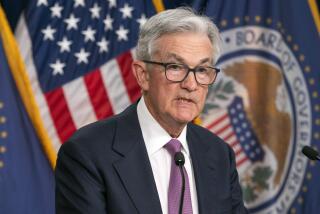Federal Reserve was more cautious about raising rates than it let on

Minutes of the Federal Reserve’s December meeting — during which it voted to raise interest rates a quarter of a point — revealed that policymakers took a more cautious approach to further increases than their public statement at the time indicated.
The vote to hike the benchmark federal funds rate to a range of 2.25% to 2.5% was unanimous but the minutes showed “a few participants” favored no change. The minutes showed the committee was attentive to recent financial market volatility and other economic risks.
“Many participants expressed the view that, especially in an environment of muted inflation pressures, the committee could afford to be patient about further policy firming,’’ the central bank said in minutes of its Dec. 18-19 policy meeting released Wednesday.
“Participants expressed that recent developments, including the volatility in financial markets and the increased concerns about global growth, made the appropriate extent and timing of future policy firming less clear than earlier,” the minutes said.
Officials signaled that further gradual increases in the policy rate were likely, though several participants said that it might be appropriate “over upcoming meetings to remove forward guidance entirely.” They suggested replacing it with language emphasizing “the data-dependent nature” of monetary policy decisions.
The meeting was the most significant of Jerome H. Powell’s chairmanship so far. Officials raised rates and projected two more hikes in 2019, ignoring President Trump’s demands for a halt amid steep losses in the stock market, which deepened after their decision.
Last month became the worst December for U.S. stocks since the Great Depression, with the rout continuing after Bloomberg News reported that Trump had discussed firing Powell. There was no direct reference to Trump in the minutes.
Participants discussed five distinct downside risks to the economic outlook, including: a sharper-than-expected decline in global growth; a faster fading of fiscal stimulus; heightened trade tensions; further tightening of financial conditions; and a greater-than-expected negative impact from monetary policy tightening so far.
For upside risks, participants noted that the effects of stimulus could be larger than expected and that uncertainties around global growth and trade tensions could be resolved favorably, while citing conditions that could lead to stronger inflationary pressures.
“In general, participants agreed that risks to the outlook appeared roughly balanced, although some noted that downside risks may have increased of late,” the minutes said.
Since the meeting, Fed officials have assured investors that their outlook for higher rates depends on the economy performing as expected.
Powell said Friday he was “listening sensitively to the message that markets are sending” about downside risks. The dovish tone of his comments, plus a strong December payroll report, helped stocks rally 3.4% on the day.
The minutes showed U.S. central bankers also held a wide-ranging discussion on their balance sheet, which the Fed has been winding down after building it up to help the economy recover from the recession. However, they did not commit to any strategy.
Some investors have blamed the shrinking balance sheet for causing turbulence in financial markets. Trump also appeared to refer to the runoff in a Dec. 18 tweet in which he urged the central bank to “Stop with the 50 B’s. Feel the market.’’
More to Read
Inside the business of entertainment
The Wide Shot brings you news, analysis and insights on everything from streaming wars to production — and what it all means for the future.
You may occasionally receive promotional content from the Los Angeles Times.








